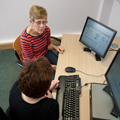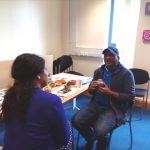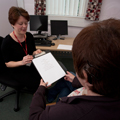Following your operation you will be given a rest and healing period of typical 2-4 weeks before switch on:
Operation
Operation: After the operation up to one month is necessary for the operation site to heal. You will have made provisions at work and at home about how you with communicate etc during this period. And you will have received advice before the operation regarding this period of time.
⇓
Initial Programming & Rehabiliation
Around 2-4 weeks after the operation adults will receive initial programming of their speech processor and a course of rehabilitation. These appointments are typically carried out at the centre over the first year following surgery. This usually involves five visits to the Yorkshire Auditory Implant Service and demands a high level of commitment from the implant recipient. Visits then become less frequent but will still be necessary throughout the rest of the adult’s life.
Initial Programming and Rehabilitation: During the initial programming the external parts of the cochlear implant are fitted by the audiologist. The speech processor is then programmed to suit each individual. A course of rehabilitation with the Speech and Language Therapist to learn to listen with the cochlear implant starts at the first switch on appointment.
Around 4 weeks after the implant operation you will be invited for their switch on appointment.
You will be seen at The Listening for Life Centre by the audiology team.
At this appointment we want to start setting up the processors ready for turning them on for the first time. This is called programming or mapping. We will use a series of appointments to create programmes or maps, that allow you to listen to the quiet sounds, whilst making sure nothing is too loud.
Maps can be changed whenever there is a reason to do it, and we have lots of ways to check your listening is good.
We will test the quietest sounds you can hear. This can be tricky as this is the first time they are listening through the processor and they may not have heard these sounds before.
After this we want to check how loud we can make the sounds before your child finds them uncomfortable. This is important as every child is different. Sometimes children can get a little upset or tearful during this and its ok to give them a cuddle if this happens. We will watch your child very closely to make sure there is no ‘non-auditory’ stimulation – this could be a twitch or blink in response to the sounds.
We initially turn the processors on at a very quiet level and work our way up, so you may not see your child react to sounds straight away. We gradually make the processors louder until we start to see your child make some reaction to sounds. Sometimes a child may smile or laugh, or sometimes they can become a little upset or frightened. All children are different. Over the next few appointments we will gradually build a clearer picture of your child’s hearing and we aim to progress with the programming until we are sure your child is hearing quiet sounds, whilst remaining comfortable.
⇓
Intensive Rehabilitation & Reprogramming
Rehabilitation and Reprogramming: Usually there are four to five appointments in the first three months. The speech processor will continue to be reprogrammed to provide optimal perception of sound for the cochlear implant user.
The course of rehabilitation will support the individual in developing their listening skills which may include helping the cochlear implant user to identify ways to have more conversations. It may also involve carrying out listening tasks at home with an identified person such as a member of the family or a friend. The speech and language therapist may offer support with regards to using the telephone, music appreciation, managing in difficult communication situations and improving speech intelligibility if this is required. Individual and group rehabilitation is offered.
The Adult Rehabilitation Team is currently Jillian and Julie who are both experienced speech and language therapists. When you have had your cochlear implant and are getting started with listening again they will see you for individual sessions to work on your listening goals. They will suggest activities and listening exercises that will help you to make good progress and adapt fully to the cochlear implant. The team are always available, no matter how long you have had your implant, to help with any listening or communication challenges you may need suppport with at home, in education or at work.
The Adult Rehab Service offers a group programme which includes a telephone rehab session, getting more out of music session, a conversation group for older adults as well as regular cochlear implant user groups which are an opportunity for people who have cochlear implants to get together socially and support each other.
⇓
Beyond (clinic annually or as required & rehabilitation as required + group invitations.
Reprogramming as Required: Over the following years adults may need the speech processor to be reprogrammed. They should contact the department as soon as they realise this is necessary.
Reassessment: Reassessments are carried out to measure the benefit gained from the cochlear implant. These assessments are exactly the same as those carried out before the operation. They are carried out at certain times after the operation, usually at three months, nine months and two years post implant and sometimes thereafter.
Clinic Reviews: Adults will be seen by the ENT Consultant one year after surgery. The clinic visit is to check the adult’s health in relation to the cochlear implant. If the cochlear implant recipient has any concerns with regards to their implant they should contact the department for advice.


